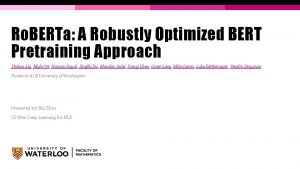Optimized entropyconstrained vector quantization of lossy vector map

- Slides: 1

Optimized entropy-constrained vector quantization of lossy vector map compression Minjie 1 Speech 1 Chen , Mantao 2 Xu , Pasi 1 Fränti and Image Processing Unit, School of Computing, Univ. of Eastern Finland, Finland 2 School of Electronics & Information, Shanghai Dian. Ji University, China Methodology Introduction Vector map, which consists of geographic information such as waypoints, routes and areas, is represented as a sequence of points in a given coordinate system. Differential coordinates of subsequent sampling points are considered as the prediction error and vector quantization are designed on these residual vectors. Vector quantization (with codebook) is designed for most common vectors, and the remaining vectors (outliers) are coded by additional bits using uniform quantization (without codebook). Dynamic programming method is then utilized to improve the quantized vector selection in closed-loop framework. • Size of codebook: 78 • bit-rate: 5 bit/point • Minimize: J = ∑D(Distortion) + λ R(Rate) • Initialized by entropy-constrained pairwise nearest neighbour (ECPNN) • MSE = 8. 7∙ 10 -6 Britain Map with 10910 points and its differential coordinates Experiments Performance comparison All points are encoded: • Clustering-based method (CBC) • Reference Line (RL) • Optimal entropy-constrained vector quantization (OCVQ) An approximated curve is encoded: • Dynamic Quantization (DQ) • OCVQ integrated into DQ (OCVQ +DQ) Cost of Residual vector vi represent by jth element in codebook: SET When λ is known, optimal l is determined! This is derived by setting ∂∑Joi/∂l=0 Estimate cost when value [vi/l] is coded (any distribution fit the data e. g. geometric, uniform, Poisson, negative binomial…) Iterated process like k-means, but with one additional “outlier” cluster Workflow λ is updated by binary search • Size of codebook: 30 to find the best solution under • bit-rate: 5 bit/point given bit constraint -6 • MSE = 6. 3∙ 10 • Better performance than both method Conclusions Two-level strategy is employed to optimize the codebook design. Proposed method has an optimal size of codebook When high bit-rate is required, most vectors are coded as “outlier” When high compression-rate is required, most vectors are coded by codebook vectors For further information: http: //cs. joensuu. fi/sipu

